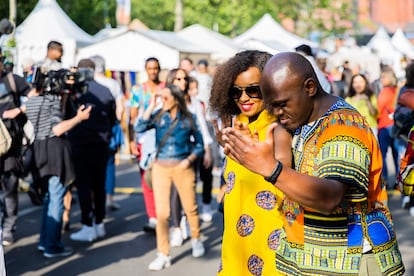Kizomba, the dance that unites Angola
Created almost half a century ago and recently declared an intangible cultural heritage, this musical style is a hallmark of an African country that still bears the scars of war

Angola still bears the scars of war. Unexploded mines, buildings riddled with bullet holes, and half-buried, rusty shell casings lie on its roads. The country is struggling to put the aftermath of war behind it, but there is one element that runs through every chapter of recent history: since its independence from Portugal in 1975, the nation’s musical thread has been characterized by the rise of a new style. It consists of a mix of African and Caribbean rhythms that led to kizomba, a dance with a soft cadence, elegant leg movements and an extreme connection with one’s partner.
Since its inception almost half a century ago, this genre has linked the country’s colonial past with the tragedy of the civil conflict, which ended in 2002, and the current situation. It has captured the reality of Angola through lyrics about the battlefield, testimonies of everyday life, romances, and expressions of joy and revelry: after all, kizomba comes from the Quimbundo language and means “party” or “celebration.” It has also branched out into new artistic fields, inoculating its rhythm into other traditional dances and into urban music. In April Angola declared it an intangible cultural heritage.
“Kizomba is part of our lives, but also of those who have gone to Europe or North America. It is something that belongs to every Angolan; we hear it every day on the radio, on television, in the street, while we cook… If you were born here, it is more than music or dance: it is a social element, a part of your identity,” explains Rui Djassi Moracén, founder of the University of Kizomba, an online platform that promotes the country’s culture.
The expert does not hesitate to point to Eduardo Paím as the father of the genre. Born 60 years ago in the bordering Democratic Republic of the Congo, he is considered the creator of kizomba in the early 1980s, when he gave a twist to the semba, another native genre, adding sounds from the Antilles such as souk. “I grew up listening to an infinite number of styles. And fusing these influences led to what is now called kizomba,” the musician explained in an interview he gave in 2019 to Euronews. “It is poetry in steps. The term is even used to write the choreography on the floor,” he pointed out, speaking of the “nakedness of the soul” that it implies.
“It emerged as an exchange between Angola and European settlers. With independence in 1975, it was formulated as a cultural renaissance. During the war, until 2002, it was a sign of resistance and hope. Now it represents that heritage and the pride of the country,” sums up Eddy Vents, a professor and promoter of kizomba from Guinea-Bissau who currently resides in the United States. Vents points out that the melody responds to a blend of interoceanic genres, but “it was in Portugal where it expanded, recruiting fans from all over the planet.”
Thanks to this two-way journey, the musical genre has crossed borders and reached American and European capitals. In Madrid, Jeissy Kevin Djaffy teaches kizomba classes and organizes international festivals. “It was once related to politics, and they even say that it was used as a method to send messages during the war, but now it is pure fun,” says the promoter. “We must bear in mind that dance is the only thing we have. We are a poor but happy continent,” he points out, agreeing with Eduardo Paím’s opinion: “Kizomba is a milestone, a reference: it is the way in which Angola imposes itself in the world.”
Sign up for our weekly newsletter to get more English-language news coverage from EL PAÍS USA Edition
Tu suscripción se está usando en otro dispositivo
¿Quieres añadir otro usuario a tu suscripción?
Si continúas leyendo en este dispositivo, no se podrá leer en el otro.
FlechaTu suscripción se está usando en otro dispositivo y solo puedes acceder a EL PAÍS desde un dispositivo a la vez.
Si quieres compartir tu cuenta, cambia tu suscripción a la modalidad Premium, así podrás añadir otro usuario. Cada uno accederá con su propia cuenta de email, lo que os permitirá personalizar vuestra experiencia en EL PAÍS.
¿Tienes una suscripción de empresa? Accede aquí para contratar más cuentas.
En el caso de no saber quién está usando tu cuenta, te recomendamos cambiar tu contraseña aquí.
Si decides continuar compartiendo tu cuenta, este mensaje se mostrará en tu dispositivo y en el de la otra persona que está usando tu cuenta de forma indefinida, afectando a tu experiencia de lectura. Puedes consultar aquí los términos y condiciones de la suscripción digital.
More information
Archived In
Últimas noticias
Maduro pleads not guilty before the federal court in New York: ‘I am still the president of Venezuela’
A new test can detect Alzheimer’s from a finger prick
UN team enters Sudanese city of El Fasher after paramilitary massacre: ‘It’s like a ghost town’
A recipe for resistance: Indigenous peoples politicize their struggles from the kitchen
Most viewed
- Gilles Lipovetsky: ‘If you want to live better and fall in love, take Prozac, don’t look to philosophy’
- Alain Aspect, Nobel laureate in physics: ‘Einstein was so smart that he would have had to recognize quantum entanglement’
- Alvin Hellerstein, a 92-year-old judge appointed by Bill Clinton, to preside over Maduro’s trial in New York
- Maduro’s downfall puts China’s relationship with Venezuela to the test
- Why oil has been at the center of Venezuela-US conflicts for decades










































